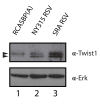Cellular processes of v-Src transformation revealed by gene profiling of primary cells--implications for human cancer
- PMID: 20152043
- PMCID: PMC2837010
- DOI: 10.1186/1471-2407-10-41
Cellular processes of v-Src transformation revealed by gene profiling of primary cells--implications for human cancer
Abstract
Background: Cell transformation by the Src tyrosine kinase is characterized by extensive changes in gene expression. In this study, we took advantage of several strains of the Rous sarcoma virus (RSV) to characterize the patterns of v-Src-dependent gene expression in two different primary cell types, namely chicken embryo fibroblasts (CEF) and chicken neuroretinal (CNR) cells. We identified a common set of v-Src regulated genes and assessed if their expression is associated with disease-free survival using several independent human tumor data sets.
Methods: CEF and CNR cells were infected with transforming, non-transforming, and temperature sensitive mutants of RSV to identify the patterns of gene expression in response to v-Src-transformation. Microarray analysis was used to measure changes in gene expression and to define a common set of v-Src regulated genes (CSR genes) in CEF and CNR cells. A clustering enrichment regime using the CSR genes and two independent breast tumor data-sets was used to identify a 42-gene aggressive tumor gene signature. The aggressive gene signature was tested for its prognostic value by conducting survival analyses on six additional tumor data sets.
Results: The analysis of CEF and CNR cells revealed that cell transformation by v-Src alters the expression of 6% of the protein coding genes of the genome. A common set of 175 v-Src regulated genes (CSR genes) was regulated in both CEF and CNR cells. Within the CSR gene set, a group of 42 v-Src inducible genes was associated with reduced disease- and metastasis-free survival in several independent patient cohorts with breast or lung cancer. Gene classes represented within this group include DNA replication, cell cycle, the DNA damage and stress responses, and blood vessel morphogenesis.
Conclusion: By studying the v-Src-dependent changes in gene expression in two types of primary cells, we identified a set of 42 inducible genes associated with poor prognosis in breast and lung cancer. The identification of these genes provides a set of biomarkers of aggressive tumor behavior and a framework for the study of cancer cells characterized by elevated Src kinase activity.
Figures





Similar articles
-
JunD/AP-1 Antagonizes the Induction of DAPK1 To Promote the Survival of v-Src-Transformed Cells.J Virol. 2016 Dec 16;91(1):e01925-16. doi: 10.1128/JVI.01925-16. Print 2017 Jan 1. J Virol. 2016. PMID: 27795443 Free PMC article.
-
Reduced phosphotyrosine binding by the v-Src SH2 domain is compatible with wild-type transformation.Oncogene. 1996 Feb 15;12(4):727-34. Oncogene. 1996. PMID: 8632894
-
Transforming properties and substrate specificities of the protein tyrosine kinase oncogenes ros and src and their recombinants.J Virol. 1992 Aug;66(8):4909-18. doi: 10.1128/JVI.66.8.4909-4918.1992. J Virol. 1992. PMID: 1321277 Free PMC article.
-
Cloning and characterization of a thermolabile v-src gene for use in reversible transformation of mammalian cells.Oncogene. 1992 Jun;7(6):1207-14. Oncogene. 1992. PMID: 1375718
-
The road to Src.Oncogene. 2004 Oct 18;23(48):7910-7. doi: 10.1038/sj.onc.1208077. Oncogene. 2004. PMID: 15489909 Review.
Cited by
-
JunD/AP-1 Antagonizes the Induction of DAPK1 To Promote the Survival of v-Src-Transformed Cells.J Virol. 2016 Dec 16;91(1):e01925-16. doi: 10.1128/JVI.01925-16. Print 2017 Jan 1. J Virol. 2016. PMID: 27795443 Free PMC article.
-
Depletion of the histone chaperone tNASP inhibits proliferation and induces apoptosis in prostate cancer PC-3 cells.Reprod Biol Endocrinol. 2011 Apr 16;9:50. doi: 10.1186/1477-7827-9-50. Reprod Biol Endocrinol. 2011. PMID: 21496299 Free PMC article.
-
Pleiotropic action of AP-1 in v-Src-transformed cells.J Virol. 2011 Jul;85(13):6725-35. doi: 10.1128/JVI.01013-10. Epub 2011 Apr 20. J Virol. 2011. PMID: 21507983 Free PMC article.
-
Cytokinesis Failure Leading to Chromosome Instability in v-Src-Induced Oncogenesis.Int J Mol Sci. 2017 Apr 12;18(4):811. doi: 10.3390/ijms18040811. Int J Mol Sci. 2017. PMID: 28417908 Free PMC article. Review.
-
Characterization of the Src-regulated kinome identifies SGK1 as a key mediator of Src-induced transformation.Nat Commun. 2019 Jan 17;10(1):296. doi: 10.1038/s41467-018-08154-1. Nat Commun. 2019. PMID: 30655532 Free PMC article.
References
Publication types
MeSH terms
Substances
Grants and funding
LinkOut - more resources
Full Text Sources
Molecular Biology Databases
Miscellaneous

